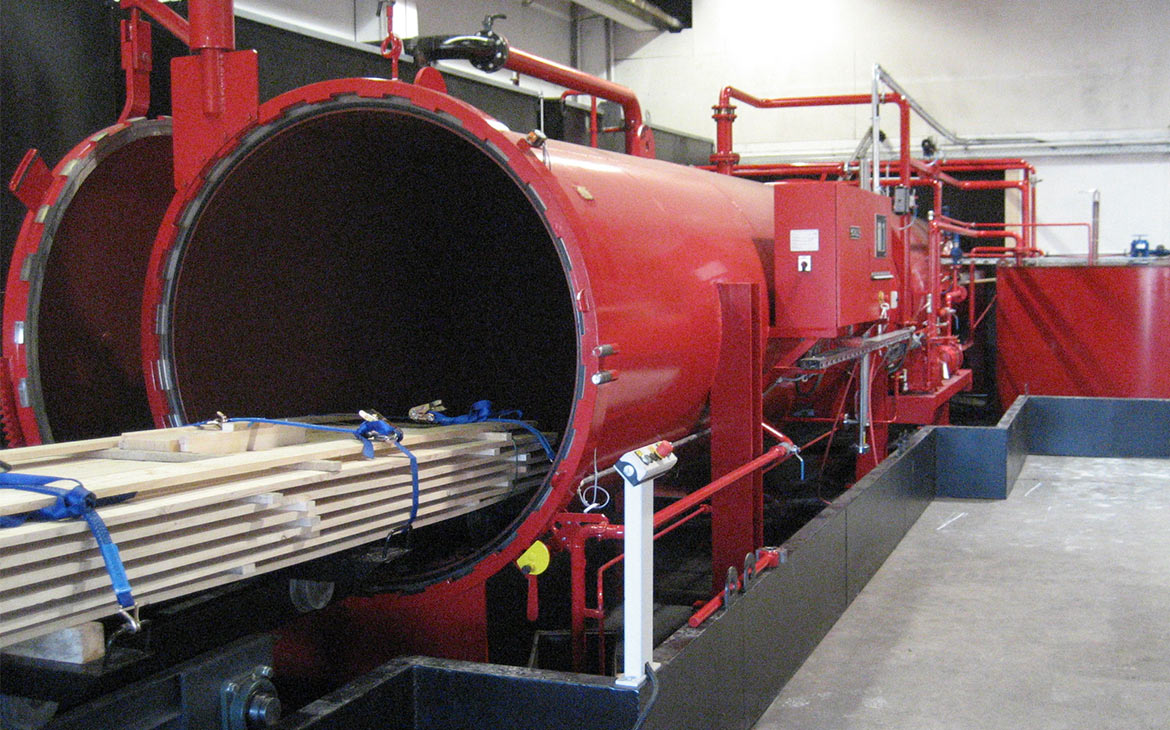Wolmanit® Firestop

Pressure impregnation of wood panels with Wolmanit® Firestop
Wolmanit® Firestop – an effective fire protection solution for contemporary fire protection of wood and wood-based materials.
Wolmanit® Firestop is a fire protection salt specially developed for the pressure impregnation of wood and wood-based materials. After deep impregnation into the wood in a vacuum pressure process, Wolmanit® Firestop enables the best possible building material classes/classifications to be achieved for wood and wood-based materials as combustible building materials.
Wood and wood-based materials impregnated with Wolmanit® Firestop have been successfully tested and classified according to many international standards (e.g. EN 13501-1, DIN 4102) with respect to their fire behavior. Their applicability in areas with increased fire protection requirements in accordance with applicable building regulations is confirmed by the available classification reports and approvals.
For specific applications or reduced fire protection requirements, Wolmanit® Firestop can also be used very flexibly and effectively by means of dip or spray application.
Advantages of Wolmanit® Firestop
Wolmanit® Firestop is used in many projects as the preferred fire protection solution and offers comprehensive advantages over alternative systems.
- Effective and flexible: Wolmanit® Firestop is a highly effective fire protection salt for the protection of wood and wood-based materials. Inserted deep into the wood by means of pressure impregnation, Wolmanit® Firestop enables the best possible building material classes/classifications to be achieved for combustible building materials, e.g. EN 13501-1 (Euroclass B-s1/s2, d0), DIN 4102-T1 (building material class B1 - flame retardant). In contrast to surface-applied fire protection systems, Wolmanit® Firestop leaves room for subsequent mechanical treatment of the protected wood, even without extensive post-treatment – for greater flexibility in processing and application.
- Natural and harmless: Wolmanit® Firestop is colorless and penetrates deep into the wood. The natural character of the wood is completely preserved. Wolmanit® Firestop treated wood is considered harmless to health and the environment when used as directed. This enables components manufactured with Wolmanit® Firestop impregnated wood to achieve the highest environmental quality seals, as e.g. natureplus.
- Safe and reliable: Industrial application using the vacuum pressure treatment method guarantees simple, safe and exposure-free application in a closed system. The quality of the fire protection treatment can be reliably controlled and ensured. In the event of damages to the surface of the treated wood, the deep penetration of the active ingredients into its structure will leave no concerns with regard to the fire protective action.
Fields of application for Wolmanit® Firestop
Wolmanit® Firestop – an effective fire protection solution for a wide range of interior and exterior applications.
According to building regulations, structures must be designed in such a way that the development and spread of fire as well as smoke are prevented. In the event of fire lives need to be rescued and effective firefighting must be possible. Wood and wood-based products are valued for their excellent structural, mechanical and physical properties. In order to enable their use as building materials in fire-sensitive areas, additional effective protection against the effects of fire and radiant heat is required. With Wolmanit® Firestop, we offer the wood industry an innovative and beneficial method to extend the use of wood as a natural and sustainable building material to areas with increased fire protection requirements, and gives architects, planners and builders more freedom to realize their ideas in wood and wood-based materials.
Typical applications for Wolmanit® Firestop-impregnated wood and wood-based materials include:
- Facades / cladding
- Ceilings / acoustic ceilings
- Engineered timber construction (structural timber, CLT, Glulam, nail trusses)
- Solid wood / 3-S / plywood panels
- Exhibition / theatre / stage / sports hall construction
- Transportation (railroad, shipbuilding),
- Scaffolding planks
- Pallets
- and many more
Please contact our technical consulting service for more information on Wolmanit® Firestop, available classification reports/approvals, detailed discussion of your requirements and assistance in developing an optimal solution for your application.
Wolmanit® Firestop properties
Wolmanit® Firestop – Convincing properties
In addition to the advantages already presented, we have summarized the main properties of Wolmanit® Firestop below.
- Phosphate-based fire protection salt formulation for vacuum pressure treatment of wood and wood-based materials
- Compliance with the requirements under REACH
- Wolmanit® Firestop-treated wood, when used as directed, is considered safe
- Is considered harmless regarding health and the environment
- Meets the requirements for VOC/SVOC emissions in the test chamber test according to AgBB or category A+ following the French VOC regulation
- Safe and reliable application in a vacuum pressure treatment plant
- Wolmanit® Firestop treated wood and wood-based products usually retain their natural appearance
- Low tendency of salt formulation ingredients to wash out
- Large number of general technical approvals available
- General supervisory test certificate DIN 4102-1 (B1 – “low flammability”)
- Classification reports according to EN 13501-1 (B-s2/s1, d0)
- Enables fire protection solutions for interior and exterior use
Wolmanit® Firestop mode of action
In the event of fire, the generated heat induces an effective synergy between various physical and chemical mechanisms within Wolmanit® Firestop.
When exposed to fire or radiant heat, Wolmanit® Firestop impregnated into the wood causes delayed ignition of the substrate, slower flame spread over the wood surface, and a reduction in the rate of energy release. The spread of fire is significantly slowed down compared to untreated wood.
- Delays the ignition of the wood
- Slows down the spread of fire over the wood surface
- Reduces the rate of heat released from wood and thus slows down the dynamics of a developing fire
- Accelerates the formation of a fire-resistant and heat-insulating charcoal layer (leads to self-protection)
- Reduces the concentration of combustible pyrolysis gases by gas splitting and removes additional oxygen from the fire by burning the resulting gases (fire-stifling effect)
- Helps to effectively suppress radical chain reactions
- Introduces a cooling effect by creating water as by-product and absorbing energy through endothermic processes
